

Medica. Water Research. Water in situ. Water Nutrition. Water Solutions. Biological Health. Health Publica. New Health Concerns.
Food Facts. Mis en place. Food Frights. GMO's, Good for Whom? Farm Wars. Fractured Paradigm. True Farmers. We Are What We Eat. Seeds at Risk in AgroBusiness. Water Research. Water Solutions. New Ecology. Antarah Organica. Seriously? Issues. Local Harvest / Farmers Markets / Family Farms / CSA / Organic Food. Food Organizations. Food Water Exercise. Eco Ontology. Plastikos. Edible. Food Fare. Feed The People. Chef! Gustatory. Food Specifics. Tending Produce. Vegetarian.
Plants. Apiary. IUFoST International Union of Food Science and Technology. Food Tank: The Food Think Tank. Implications of climate change for agricultural productivity in the early twenty-first century. (a) Changes in mean climate The nature of agriculture and farming practices in any particular location are strongly influenced by the long-term mean climate state—the experience and infrastructure of local farming communities are generally appropriate to particular types of farming and to a particular group of crops which are known to be productive under the current climate.

Changes in the mean climate away from current states may require adjustments to current practices in order to maintain productivity, and in some cases the optimum type of farming may change. Higher growing season temperatures can significantly impact agricultural productivity, farm incomes and food security (Battisti & Naylor 2009). In mid and high latitudes, the suitability and productivity of crops are projected to increase and extend northwards, especially for cereals and cool season seed crops (Maracchi et al. 2005; Tuck et al. 2006; Olesen et al. 2007).
Table of Contents — September 27, 2010, 365 (1554) IFT.org. The Third Monodzukuri (Making Things) Nippon Grand Award. Recombinant Bovine Growth Hormone. American Meat Institute. The United States Meat Industry at a Glance. Download PocketBook PDF Download PocketBook (with Folding Instructions) PDF Feeding 312 Million Americans The meat and poultry industry is the largest segment of U.S. agriculture.
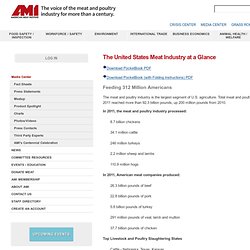
Total meat and poultry production in 2011 reached more than 92.3 billion pounds, up 200 million pounds from 2010. In 2011, the meat and poultry industry processed: 8.7 billion chickens 34.1 million cattle 246 million turkeys. The Meat Industry Now Consumes Four-Fifths of All Antibiotics. —Tom Philpott on Fri.

February 8, 2013 4:11 AM PDT. 8792_Cloning_CIR_FINAL. PoultryGuide - Poultry Farming - Chicken House. Poultry Meat and Health. Poultry is used in relation to the meat consumption of the domesticated animals.
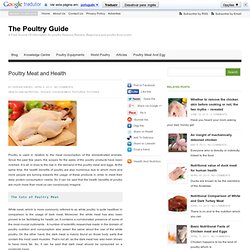
Since the past few years, the scopes for the sales of the poultry products have been notched. It is all in lines to the rise in the demand of the poultry meat and eggs. At the same time, the health benefits of poultry are also numerous due to which more and more people are turning towards the usage of these products in order to meet their daily protein consumption needs. 10 Things You Need to Know About Coffee. What Drinking Coffee Does to You. The chances are that you saw the title of this article and winced a little.

Usually, things which are enjoyable bring negative side effects to our bodies. Alcohol, chocolate and fast-food are all fine examples of things which are enjoyable at the time but have negative long-term side effects on your health. Ffee 'may make us happier': Study finds people recognise positive words more quickly when dosed with the stimulant. By Damien Gayle Published: 14:00 GMT, 13 November 2012 | Updated: 14:00 GMT, 13 November 2012.

Bees Get Buzz From Caffeine and Nicotine. Like humans, bees enjoy a little caffeine and nicotine, according to a study announced last week.
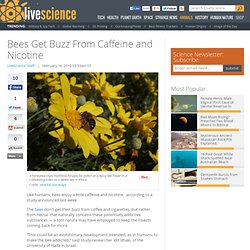
The bees don't get their buzz from coffee and cigarettes, but rather, from nectar that naturally contains these potentially addictive substances — a tool nature may have employed to keep the insects coming back for more. "This could be an evolutionary development intended, as in humans, to make the bee addicted," said study-researcher Ido Izhaki, of the University of Haifa in Israel. But the bees aren't the bug-world equivalent of caffeine junkies or pack-a-day smokers, the researchers say. Caffeine Gives Bees a Memory Boost. Honeybees, like tired office employees, like their caffeine, suggests a new study finding that bees are more likely to remember plants containing the java ingredient.
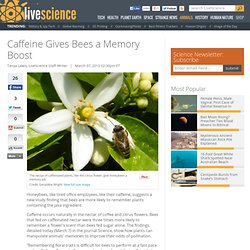
Caffeine occurs naturally in the nectar of coffee and citrus flowers. Bees that fed on caffeinated nectar were three times more likely to remember a flower's scent than bees fed sugar alone. Bees remember flowers that serve them caffeine. Honeybees, like tired office employees, like their caffeine, suggests a new study finding that bees are more likely to remember plants containing the java ingredient.
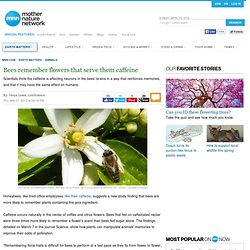
Is Trimethylxanthine Your Drug of Choice? The Benefits of Caffeine for Body Builders. Every day, 90% of Americans ingest trimethylxanthine.

It’s become our society’s drug of choice and it’s completely legal! It’s even considered good for you by many? Cravings1.jpg (JPEG Image, 468 × 2532 pixels) - Scaled (26%) Why is Eating Alkaline Foods Important? Eating an alkaline diet is important because our blood pH level needs to stay between 7.35 and 7.45, which is slightly alkaline.
It takes work for our bodies to stay balanced within this small window, and the more acidic our diet, the more we work against our body’s efforts. In turn, we leave ourselves feeling tired, and our immune systems vulnerable to disease. Alkaline diet helps balance blood pH level. Use baking soda for easy-to-peel hard-boiled eggs. Nutritive and Nonnutritive Sweetener Resources. Nutritive and nonnutritive sweeteners enhance the flavor and/or texture of food.
Nutritive sweeteners provide the body with calories, while nonnutritive sweeteners are very low in calories or contain no calories at all. They can both be added to food and beverages. General Resources The following resources below provide general information about both types of sweeteners. Brix. Human Media: Diet Climate Connection. The changing palate of America. Secret Menus Give Restaurants A Not-So-Secret Boost : The Salt. Eco-Labels. Food, Drink, Health. Grow your own food. Food. Food, Farming & Cooking. Five Global Seed Banks That Are Protecting Biodiversity. 2inShare Share. Wild bees enhance honey bees' pollination of hybrid sunflower. Health Benefits Of Honey. The Survival Spot Blog. Throughout history honey has been considered a food with unparalleled nutritional and physical benefits. The aloe vera miracle: A natural medicine for cancer, cholesterol, diabetes, inflammation, IBS, and other health conditions.
Amla (Emblica officinalis Gaertn), a wonde... [Eur J Cancer Prev. 2011. Amla. "Doomsday Seed Vault” in the Arctic. “Doomsday Seed Vault” in the Arctic. F. William Engdahl. Nutrition. How Many Calories Do You Need to Lose Weight, Maintain Weight, and Gain Weight. Let Them Eat Fat: In Praise of Fatty Foods. A Project of the Weston A. Price Foundation. The Beginner's Guide to the Paleo Diet. The Neglected Nutritional Research of Dr. Weston Price, DDS.
5 Reasons Why Butter is a Superfood. Why Butter Is Better. Fat Soluble Vitamins: Vitamins A, D, E & K. Alcohol in Powder Form. MCT oil in the ketogenic diet. Hyperlipid. ChooseMyPlate.gov.